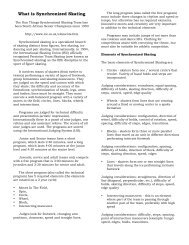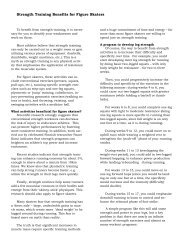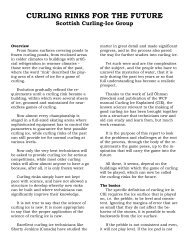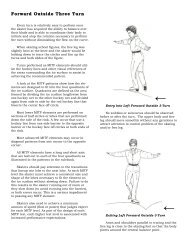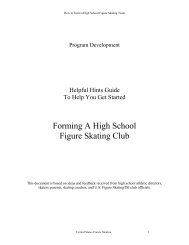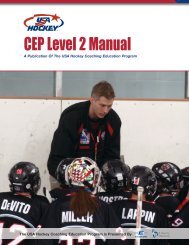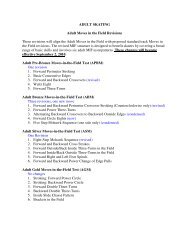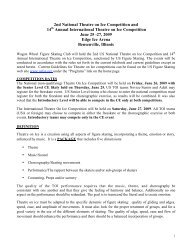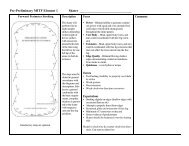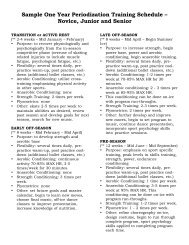CEP Level 3 Manual - Rushmore Hockey Association
CEP Level 3 Manual - Rushmore Hockey Association
CEP Level 3 Manual - Rushmore Hockey Association
Create successful ePaper yourself
Turn your PDF publications into a flip-book with our unique Google optimized e-Paper software.
T A B L E O F C O N T E N T Slevel of performance is Strength + Speed + Power +Conditioning (Aerobic and Anaerobic) +Athleticism + Nutrition + Recovery.The following questions and answers touchupon the basics of conditioning for hockey.Q1.Should hockey players be concerned withboth the Aerobic and Anaerobic energysystems?A1. Anaerobic. This is a question that brings upmuch discussion and debate. Somecoaches are still spending late spring andearly summer running laps around a track.Others are spending the majority of timeperforming sprint training. Is there aneffective means of training the major energysystems required in this highly complexgame?The main focus should be on thepredominant energy system being used.Means of conditioning that system should beas specific as possible. While a hockeyplayer should be concerned with both of theenergy systems, it should be known that thebulk of conditioning should be Anaerobic.A good Aerobic (w/oxygen) base should bedeveloped in order to aid in the recovery ofthe damage done by the anaerobic systems.However, this base can be built up through ahigh volume of anaerobic training with theoccasional aerobic bout. Interval training isan excellent way of targeting both thesystems. Monitoring the work to restintervals will determine what system will beworking the most. A highly developedAnaerobic System (w/out oxygen) will assistthe hockey players in their shifts using the offtime as a rest interval. Means of improvingthe Anaerobic system include: wind sprints,slide board sprints, racquetball, inline skating,intervals, and tempo runs. Concentrate oninterval work (800’s, 400’s, 200’s), slideboards, and different forms of tempos onfootball/soccer fields.Q2. Does a hockey player need to work onMuscular Power more than MuscularEndurance?A2. Yes. The definition of Power: P=Force xVelocity. Performance is usually determinedby the amount of power he/she can produce.Remember that a powerful skater is betterthan a strong skater. A high force initiatedon the ice at a high velocity will produce asignificant amount of skating power.Muscular Endurance is the ability to exert asub-maximal force over a prolonged periodof time. A hockey player needs a base suchas performing leg circuits in the early offseasonto endure what lies before him/her.The endurance level will also increase asAnaerobic conditioning increases. Thetraining program for these components dovary. Muscular endurance can be attainedby performing circuit and/or interval training.However, the path (Aerobic/Anaerobic) oftraining, will impact the whole career. Powerand Strength should be the focus throughweight training, plyometrics, and sprints.Q3. To stretch or not to stretch?A3. Stretch!!! It is not a hard question to answer.Flexibility is defined as the ability to move ajoint or a group of muscles through a specificrange of motion without causing injury. Poorflexibility will impact speed, agility, poweroutput, and recovery time negatively. Beingflexible will also reduce the chance of injuryto joints and muscles as well.There are many different basic stretchingtechniques that can be implemented; Staticstretches, PNF, Dynamic, Mobility, Ballistics.The areas to stress are:1. Adductors2. Abductors3. Hamstrings4. Core (Low back/Abdominals)5. Shoulders6. Internal/External Hip RotatorsStretching should be done after an easywarm-up. A consistent stretching programwill increase flexibility and reduce the chanceof an injury. If time is not allowed for aproper stretching routine to take place, thefocus should be placed on a continuouswarm-up. This includes large total bodymovements that takes the body through awide variety of hockey specific motions.Stretching should be done before, during andafter weight training, practice, games, sprintsand plyometrics. Be sure to avoid overstretchingwhich may lead to hyper-mobilityof some joints (i.e., shoulders).Q4. Is Core Strength and Stability importantto a hockey player?A4. Major Importance! Core Strength is a keyelement that many youth players andcoaches neglect. The Core (low back,abdominals, hips, and obliques) obviouslylinks the lower body to the upper body. Butmore importantly, a strong core allows ahockey player to transfer the powergenerated by the lower body to the upperbody, absorb and generate impact and skateefficiently. When skating, the core/trunkarea is in a constant state of isometriccontraction which allows the skater to bettercontrol his/her movements. There are manydifferent factors and motions that contributeto having a strong and stable core area. Thisarea should be trained in a fashion such thatis multi-dimensional and multi-plane. Alwaystrain all of the muscles to avoid imbalances.1. Flexion2. Extension3. Lateral flexion4. Hyperextension5. Rotation6. Diagonal rotation7. Stabilization (isometrics)All of these motions must be targeted inorder to prepare for the onslaught of checks(given and taken), shots on goal, falls,changes of direction, etc. Take caution whentraining the core and remember that we aretrying to prevent injuries, not have themoccur.Q5. How does it all fit together?A5. It all fits together in a well organized formatknown as Periodization. Periodization is achanging and/or manipulating of the trainingstimulus over the course of a year. Load,intensity, tempo, recovery, mode of exercise,and focus on conditioning are structured tofit the proper time of the year. The factorsthat determine the cycles or phases areusually the competitions. However, inhockey, competitions span over a long periodof time. The following page charts theperiodization over a year for hockey.136 | USA <strong>Hockey</strong> Coaching Education Program <strong>Level</strong> 3 <strong>Manual</strong>Growth and Fitness Development | 137



